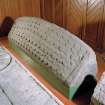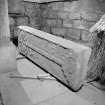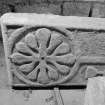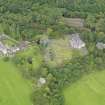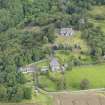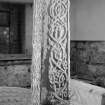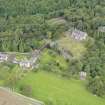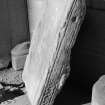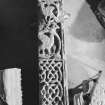Abercorn Churchyard
Burial Ground (Period Unassigned), Cross(S) (Period Unassigned), Hogback Stone(S) (Early Medieval)
Site Name Abercorn Churchyard
Classification Burial Ground (Period Unassigned), Cross(S) (Period Unassigned), Hogback Stone(S) (Early Medieval)
Canmore ID 251978
Site Number NT07NE 1.01
NGR NT 08147 79077
NGR Description Centred NT 08147 79077
Datum OSGB36 - NGR
Permalink http://canmore.org.uk/site/251978
- Council West Lothian
- Parish Abercorn (West Lothian)
- Former Region Lothian
- Former District West Lothian
- Former County West Lothian
Abercorn Kirk, from 11th century
As Norman parish kirks go in Scotland, Abercorn must have been a fairly substantial example - wide nave and choir, the latter tenanted by the splendid Hopetoun Loft. Most of what you see is by Peter MacGregor Chalmers, 1893. Two stained-glass windows by Douglas Strachan, 1921. Fine 12th-century south door, chevron stonework in tympanum, and west door, 1893, in ferociously crisp Norman with grimacing gargoyles. Aisles sprout from the torso so much as to conceal it: the Binns aisle, 1618; the Philpstoun burial enclosure, 1723; the Duddingston aisle, 1603; and the Hopetoun aisle, 1707. The Hopetoun Loft occupies the chancel and faces down the kirk displaying the magnificence of its panelling and fretwork screen by Alexander Eizatt, and the armorial achievement painted by Richard Waitt. The adjacent aisle is a two-storey, harled piece of swagger by Sir William Bruce, complete with pyramid roof, ashlar-panelled windows, and a wonderfully panelled retiring room above burial enclosure below. Atmospheric arboreal kirkyard. Outstanding collection of early carved stones in gatehouse.
Taken from "West Lothian: An Illustrated Architectural Guide", by Stuart Eydmann, Richard Jaques and Charles McKean, 2008. Published by the Rutland Press http://www.rias.org.uk
Abercorn 8, West Lothian, cross-shaft fragments
Measurements: H upper shaft frag 1.3m, lower shaft frag 1.8m, W 0.41m to 0.28m, D 0.31m to 0.23m
Stone type: sandstone
Place of discovery: NT 0814 7907
Present location: in museum at Abercorn Church (Canmore 251979).
Evidence for discovery: found re-used as cope-stones in the parapet of the bridge over the Midhope Burn in front of the gates to Midhope Castle, and taken to Abercorn Church in 1934.
Present condition: broken and worn.
Description
These two fragments comprise parts of faces A, B and D, all carved in relief with a plain roll moulding at the corners and an inner roll moulding to frame the panels of ornament (face C is missing entirely). The base of the shaft is plain and extends 0.38m below the lowest panel. Face A is carved with at least five panels, and the lower four complete panels are of equal size. The lowest panel and the third panel from the bottom contain patterns of turned interlace. The second panel from the bottom contains two scrolls of vinescroll inhabited by two non-identical birds, one facing right and the other facing left. Their heads, wings and tails extend outside their respective scrolls, and each has a plain pointed leaf terminating the scroll in front of its chest. The lower bird has a markedly large drilled eye with a flat sunken base, which could easily have accommodated an eye in a different material. The fourth panel is carved with two confronted quadrupeds, their reptilian heads facing right, and their elongated tails interwoven with each other’s limbs and a mesh of interlace. What survives of the top panel shows a variant of the tangled scroll, with a plain node and veined heart-shaped leaves.
Faces B and D appear to have been carved with a single panel of ornament, each containing a vine trail. On face B there are hanging short triangular berry bunches, while on face D there are both similar berry bunches and heart-shaped leaves pointing upwards.
Date: eighth century.
References: RCAHMS 1929, no 285; Calder 1938.
Desk-based information compiled by A Ritchie 2016
Abercorn 9, West Lothian, cross-slab fragment
Measurements: c H 0.50m, W 0.45m, D 0.08m (estimated from photograph)
Stone type: sandstone
Place of discovery: NT 0814 7907
Present location: inside the church in the room beneath the Hopetoun Loft.
Evidence for discovery: found in the churchyard.
Present condition: the base is broken but the carving is clear.
Description
The thick rectangular slab has been incised with an equal-armed outline cross, set on a shaft of which only the very top survives.
Date: ninth century.
References: RCAHMS 1929, no 274, cross no 4.
Desk-based information compiled by A Ritchie 2016
Abercorn 10, West Lothian, fragment of grave-marker?
Measurements: H 0.64, W 0.38m, D 0.12m
Stone type: sandstone
Place of discovery: NT 0814 7907
Present location: inside the church in the room beneath the Hopetoun Loft.
Evidence for discovery:
Present condition: the base, top and one narrow face are trimmed but the carving on the other narrow face is clear.
Description
Part of a rectangular slab carved with a roll moulding along both edges of face B with a small inner roll moulding on either side. Face A is otherwise plain but dressed smooth apart from a band of rough surface along the sinister edge. Within the frame formed by the roll moulding on face B is a three-strand interlace pattern, extending for about 0.23m, and the rest is plain. This slab appears to be an unfinished grave-marker.
Date: uncertain.
References: Aliaga-Kelly 1996, 411, fig PT 3.17.
Desk-based information compiled by A Ritchie 2016
Abercorn 11, West Lothian, recumbent grave-cover?
Measurements: L 1.83m, W 0.56m, D 0.27m
Stone type: sandstone
Place of discovery: NT 0814 7907
Present location: in the churchyard to the right of the west door of the church.
Evidence for discovery: none.
Present condition: weathered with lichen growth.
Description
This very substantial slab has two parallel grooves hollowed out of face A, perhaps designed to create a cross-shaft in relief. Narrow face D has an incised line forming a frame close to the edges of the slab. This may be an unfinished recumbent grave-cover.
Date: twelfth or thirteenth century?
References: none.
Desk-based information compiled by A Ritchie 2016
Abercorn 1, West Lothian, cross-shaft fragment
Measurements: H 1.40m, W face A 0.46m to 0.37m; face C 0.41m to 0.36m; D face B 0.23m to 0.22m; face D 0.26m to 0.22m
Stone type: sandstone
Place of discovery: NT 0814 7907
Present location: in the museum at Abercorn Church (Canmore 251979).
Evidence for discovery: found re-used as a window lintel inside the church during repairs.
Present condition: set in cement on modern plinth, worn but carving still detailed. Left margin of face C has been chiselled off.
Description
This is the upper part of a cross-shaft carved in deep relief on all four faces, with a roll moulding at the edges and an inner roll moulding on each face. At the top is the start of the missing cross-head. Face A is divided into two complete and two incomplete panels of ornament by roll mouldings. The lowest panel contains an incomplete double spiral ring-knot, above which is a panel of two-strand interlace, the pattern turned with a central break. Above again is a panel of diagonal key pattern, and at the top is the basal part of a panel, the carving of which is too damaged to make out, but which appears to be figural rather than interlace.
Face B has a single panel of complex interlaced medallion scroll with single-ridged nodes, in which each medallion contains a slightly different design of twisted sprays of trilobed berry bunches and veined pointed leaves. There are also leaves, single berries and pointed berry bunches in the spaces between the medallions. There is a wider panel of interlaced medallion scroll on face C, although the sinister margin has been damaged by later trimming. Here the medallions contain fleshy pointed leaves, single berries and trilobed berry bunches, and there are leaves and berries in the spaces outside the medallions. At the top there is the base of a panel of interlace pattern. On face D there is a single panel of scroll foliage with triple-ridged nodes, trilobed berry bunches and veined triangular leaves, two of which pass under the stem of the vine. Between each scroll is an elongated veined leaf or frond. At the top is the basal part of a panel of diagonal key pattern, which marks the base of the lower arm of the missing cross-head.
Date: eighth century.
References: ECMS pt 3, 418-19; RCAHMS 1929, no 274, cross no 1.
Desk-based information compiled by A Ritchie 2016
Abercorn 2, West Lothian, hogback grave cover
Measurements: H 0.40m to 0.60m, L 1.59m, W at ends 0.40m and 0.34m
Stone type: sandstone
Place of discovery: NT 0814 7907
Present location: in museum at Abercorn Church.
Evidence for discovery: found ‘a little to the south west’ of the church, its axis lying east/west (Russell Walker 1885, 406)
Present condition: the ridge is worn but the tegulation is clear, and the ends are truncated.
Description
Below a worn ridge band, there are on each steeply curved side seven rows of semi-circular tegulae, with a plain band at either end.
Date: eleventh century.
References: Russell Walker 1885, 406-8; ECMS pt 3, 419-20; Lang 1974, 222 (Abercorn 1).
Desk-based information compiled by A Ritchie 2016
Abercorn 3, West Lothian, cross-shaft fragment
Measurements: H 1.12m, W 0.29m, D 0.15m Inv / H 0.97m, W 0.28m, D 0.10m (ECMS)
Stone type: sandstone
Place of discovery: NT 0814 7907
Present location: Carlowrie Castle, West Lothian
Evidence for discovery: found in 1863 re-used as a window lintel in one of the outbuildings at Abercorn Manse during building works, and taken to Carlowrie Castle where it was set on a modern base against the garden wall.
Present condition: very worn and damaged.
Description
This fragment is part of a relief-carved cross-shaft, which has been split lengthways and trimmed along top, foot and one narrow face. The one intact edge has a plain roll moulding with another roll moulding on each side framing the ornament. Face A is carved with two scrolls, above which there appears to be a serpent entwined in foliage. There appear also to be foliage scrolls on face B in a repeating pattern which includes large frond-like leaves.
Date: eighth or ninth century.
References: ECMS pt 3, 420; RCAHMS 1929, no 351.
Desk-based information compiled by A Ritchie 2016.
Abercorn 4, West Lothian, cross-shaft fragment
Measurements: H 0.51m, W 0.28m, D 0.16m
Stone type: sandstone
Place of discovery: NT 0814 7907
Present location: in museum at Abercorn Church.
Evidence for discovery: found in the churchyard sometime prior to 1903.
Present condition: worn.
Description
This is the lower part of a cross-shaft carved in relief on the two broad faces above a plain base. There are roll mouldings on the edges, with an inner roll moulding on the ornamented faces. Face A is carved with the lower part of a large panel of diagonal key pattern (ECMS type 95). Face B has a lower complete panel containing ten-cord plaitwork with breaks, while the surviving strip of the panel above has square key pattern. Faces B and D are carved with double-outlined plain panels.
Date: eighth century.
References: ECMS pt 3, 420; RCAHMS 1929, no 274, cross no 5.
Desk-based information compiled by A Ritchie 2016
Abercorn 5, West Lothian, hogback grave cover
Measurements: H c 0.30m, L c 1.40m, W 0.37m to 0.40m
Stone type: sandstone
Place of discovery: NT 0814 7907
Present location: in museum at Abercorn Church.
Evidence for discovery: found on the south side of the church during the alterations to the church c 1893.
Present condition: broken into two with truncated ends, but the tegulation is crisp.
Description
The ridge is slightly curved and plain and the sides have a shallow slope. The ends are truncated but had flat plain bands. Each side is carved with five rows of neat tegulae with vertical sides, but on one side the middle three rows are smaller than the rest.
Date: early twelfth century.
References: Lang 1974, 218, 222 (Abercorn 2).
Desk-based information compiled by A Ritchie 2016
Abercorn 6, West Lothian, coped grave cover fragment
Measurements: H 0.22m, L 0.33m, W 0.41m
Stone type: sandstone
Place of discovery: NT 0814 7907
Present location: inside the church in the room beneath the Hopetoun Loft.
Evidence for discovery: found on the south side of the church c1893.
Present condition: broken but carving in good condition.
Description
This is a fragment from the upper central portion of a grave-cover, with a triple-roll ridge, 114mm wide. Below are three rows of well-cut tegulae with straight sides and rounded tips.
Date: twelfth century.
References: Lang 1974, 222 (Abercorn 3).
Desk-based information compiled by A Ritchie 2016
Abercorn 7, West Lothian, cross-head fragment
Measurements: H 0.36m, W 0.26m, D 0.30m, boss projects by 0.11m
Stone type: sandstone
Place of discovery: NT 0814 7907
Present location: inside the church in the room beneath the Hopetoun Loft.
Evidence for discovery: unknown.
Present condition: very worn and battered.
Description
The fragment includes the central area and part of the two lower arm pits. The arm pits are wide and circular, with double pelletted mouldings. Face A is carved with a circular boss 0.20m in diameter with a central rosette set on two stepped discs, while on face D there is a larger rosette of shallower profile.
Date: eighth or ninth century.
References: RCAHMS 1929, no 274, cross no 6; Calder 1938.
Desk-based information compiled by A Ritchie 2016
NT07NE 1.01 centred 08147 79077
NMRS NOTES
NT07NE 1.00 Abercorn Church
NT07NE 1.01 Abercorn Churchyard
NT07NE 1.02 Abercorn Museum
































![Photographic copy of three rubbings. The left rubbing is unidentified. The middle and right rubbings show detail from the left side [middle] and face [right] of Abercorn No. 2 cross slab.](http://i.rcahms.gov.uk/canmore/l/SC01415700.jpg)







































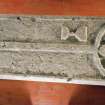









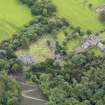


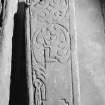





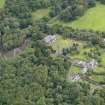

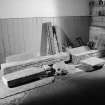
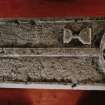


![Photographic copy of three rubbings. The left rubbing is unidentified. The middle and right rubbings show detail from the left side [middle] and face [right] of Abercorn No. 2 cross slab.](http://i.rcahms.gov.uk/canmore/s/SC01415700.jpg)

